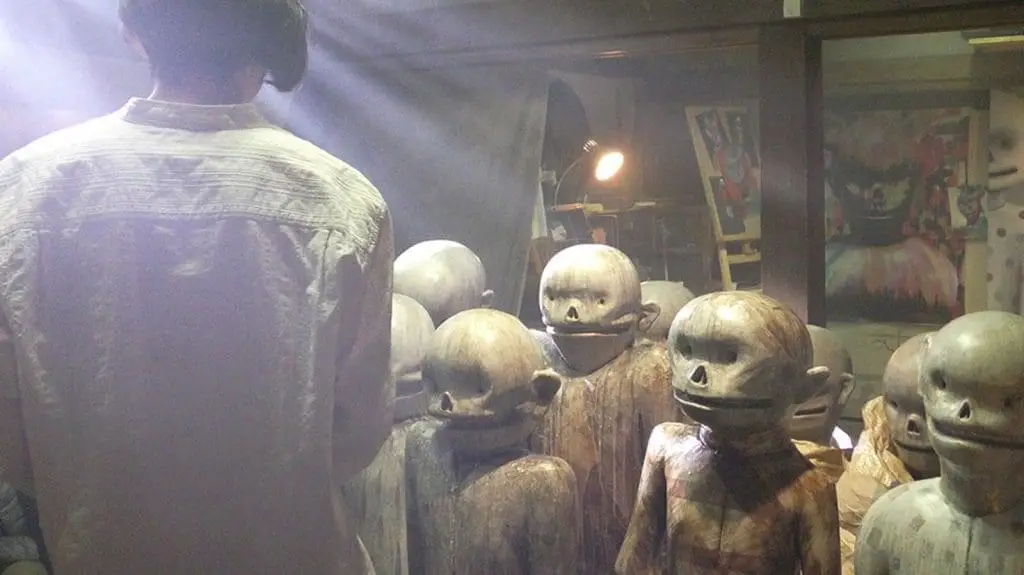
In the sun-scorched dying desert town of Black Rock, John J. Macreedy (Spencer Tracy) steps off the Streamliner train, stopping for the first time in four years, as indicated by the telegraph operator of the town, who pronounces the word “stopping” as if he’s never thought of it before that moment. And through the lens of the eminent John Sturges, Macreedy presses on through the town unconcerned by the acidic stares of the locals, headed by Reno Smith (Robert Ryan), who, like the others (Ernest Borgnine, Lee Marvin, and Anne Francis) don’t want the secret of this town known. It’s one of racism, intolerance, and downright misaimed hatred. The town of Black Rock, however, doesn’t afford the possibility of enlightenment.
As Macreedy walks through the town, sizing up the town and the people as much as they are doing to him, he has one reason why he’s here. Just a few months after WWII ended, he’s in Black Rock to find Kamoko, the father of a fellow soldier in Europe who helped him get through the rockiest time of his life, that of being fired at among other dangers. Kamoko is not a name appreciated around these parts as everyone avoids giving Macreedy any information he might need. Therefore, he becomes suspicious of some secret being hidden between the people. He wants to know. They want him out.
Sturges plays with many themes, as outlined by film history professor Dana Polan’s educated audio commentary, including that of the psychology of a group. The leader obviously is Smith, with Borgnine and Marvin following. In fact, Borgnine and Marvin make lasting impressions as Smith’s henchmen, with Borgnine seemingly programmed to lunge at Macreedy in a later scene that proves Macreedy isn’t just a man in a black suit with a paralyzed arm looking for answers. Sturges’ desert looms bigger than the equally dying buildings of this faded West. Life has indeed gone elsewhere in places like L.A., which is where Macreedy comes from.
Moreso than just the character squabbles which color the film is another theme that made “Bad Day at Black Rock” a part of Warner Bros.’ recently released “Controversial Classics Collection”, containing this and a number of other films that embody the collection’s intent: To give full weight to those films containing issues that were controversial in their day and are equally timely now. In the subject of racism, Smith spews a heck of a lot of it, racism exploded into his brain by the Japanese’s sneak attack on Pearl Harbor. His speech about this when talking with Macreedy for a second time displays a brutal honesty that’s unafraid to get to the real core of the issue. To Smith, those people weren’t people. They were, and still are to him, “mad dogs”. Human beings aren’t necessarily helpless toward changing themselves, but in Black Rock, changing is not what they’re likely to do unless they leave. And watching this set of actors go at it with each other, with Tracy as the calm center of gravity, is impressive. Men of the screen, all of them, and they truly inhabit this town as if they were actually there, Anne Francis too.
As to that commentary by Dana Polan, he gets his paycheck from the School of Cinema/Television at the University of Southern California and speaks it too. He gives an expert analysis on the film, examining what John Sturges’ intent was in his work, as well as his geometric shots and slight use of color. He sees Anne Francis as miscast in the film, but alludes to MGM’s intent to put women actors in wherever they could at that time as they had many under contract. Francis fits right into this world, masculinized by the company of these men and the hardness of Black Rock. He also expresses disappointment over Tracy not squaring off against Lee Marvin, which would be redundant, considering that his scene with Borgnine provides all the action and assertion that’s needed. Marvin is the shadow man in this one. He’s Smith’s muscle and doesn’t do much, but he’s there. That’s good enough when it comes to an actor like Marvin who, just like James Coburn, is an eternally wonderful presence. Polan obviously has copious notes in front of him for this commentary (though if most of the information came directly from his brain instead of sheets of paper, his paycheck is well-earned), but he pads the time unnecessarily with constant analysis, as if he can’t let this track go without filling it first minute to last. That’s ok in hearing one’s own voice, but for film history, not much is given either in the way of the production of this movie, though he does give tiny bits of info on where MGM was on this time, and even how this movie represented Old Hollywood slowly being replaced by New Hollywood. A theatrical trailer is also here, standard and appreciated fare for these classic DVDs.
With its refusal to give it all up right away, “Bad Day at Black Rock” puts itself near the top as a thinking film. It’s a drama that’s all about questions and how to answer them, and these men ask themselves plenty during it, even when no dialogue is heard. This is why Sturges was Sturges.
